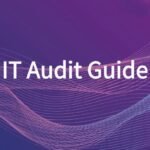IT audits rely on established frameworks to ensure audits are conducted consistently, comprehensively, and in alignment with global best practices. These IT Audit Frameworks provide structured guidance for assessing IT controls, identifying risks, and ensuring compliance with legal, regulatory, and industry-specific standards.
Understanding and applying the right IT Audit frameworks helps auditors:
- Establish audit scope and control objectives
- Map IT risks to corresponding controls
- Benchmark organizational practices against recognized standards
- Facilitate cross-industry communication and comparability
🧱 1. COBIT (Control Objectives for Information and Related Technology)
Published by: ISACA
Purpose: Provide a comprehensive framework for IT governance, management, and assurance.
Focus: Alignment of IT goals with business objectives; establishing control objectives and processes.
Key Features:
- Covers governance and management of enterprise IT
- Offers maturity models for capability assessment
- Defines 40 governance and management objectives (COBIT 2019)
- Widely used for IT audit planning, especially in risk and compliance-focused environments
Best For:
- Organizations seeking alignment between IT and business strategy
- Enterprise-level IT governance assessments
🔐 2. ISO/IEC 27001 and ISO/IEC 27002
Published by: International Organization for Standardization (ISO)
Purpose: Establish and manage a formal Information Security Management System (ISMS).
ISO 27001:
- Provides requirements for establishing, implementing, maintaining, and improving an ISMS
- Often used as a certification standard
ISO 27002:
- Provides implementation guidance and control best practices for ISO 27001’s annex controls
Key Controls Include:
- Access control
- Cryptography
- Operations and communications security
- Physical and environmental security
- Incident management
Best For:
- Organizations focused on information security, especially those handling sensitive or regulated data
- Preparing for ISO 27001 certification
🧮 3. NIST Frameworks
Published by: U.S. National Institute of Standards and Technology (NIST)
Purpose: Offer risk-based approaches for securing IT systems, especially for government and critical infrastructure.
Common NIST Publications Used in IT Audits:
- NIST SP 800-53 – Security and privacy controls for federal information systems
- NIST Cybersecurity Framework (CSF) – Risk management framework with five core functions: Identify, Protect, Detect, Respond, Recover
Best For:
- U.S. government contractors, critical infrastructure operators, or any organization seeking a rigorous cybersecurity risk framework
💼 4. ITIL (Information Technology Infrastructure Library)
Published by: AXELOS (UK Government + Capita)
Purpose: Guide IT Service Management (ITSM) to ensure high service quality and efficiency.
Focus Areas:
- Service strategy, design, transition, operation, and continual improvement
- Process efficiency and alignment of IT services with business needs
Relevance to IT Audit:
- Auditors assess if ITIL practices are implemented and followed in service delivery
- Supports audits on incident management, change control, and problem management
Best For:
- Organizations with mature ITSM environments or managing large-scale IT operations
⚖️ 5. SOX ITGC (Sarbanes-Oxley Act – IT General Controls)
Mandated by: U.S. Federal Law
Purpose: Prevent corporate fraud and ensure the integrity of financial reporting systems
SOX ITGC Areas Audited:
- Change management
- Logical access control
- Backup and recovery
- Data center physical security
Best For:
- Public companies in the U.S. or companies preparing for IPO
- Financial systems and reporting environments
🌍 6. PCI-DSS (Payment Card Industry Data Security Standard)
Published by: PCI Security Standards Council
Purpose: Protect cardholder data and reduce credit card fraud
Key Focus Areas:
- Secure network and systems
- Strong access control
- Regular monitoring and testing
- Vulnerability management
Best For:
- Organizations handling credit/debit card payments, including retailers, banks, and payment processors
🛡 7. COSO (Committee of Sponsoring Organizations of the Treadway Commission)
Purpose: Provide a broader framework for internal control over financial reporting (ICFR), including IT-related risks
Components of COSO Internal Control Framework:
- Control environment
- Risk assessment
- Control activities
- Information and communication
- Monitoring
Best For:
- Financial audits where IT supports business process controls
- Integrated audits combining IT and business controls
📘 8. SSAE 18 / SOC Reports (System and Organization Controls)
Published by: AICPA
Purpose: Report on the internal controls of service organizations
SOC Types:
- SOC 1: Focus on financial reporting controls
- SOC 2: Focus on Trust Services Criteria (security, availability, processing integrity, confidentiality, privacy)
- SOC 3: General use version of SOC 2
Best For:
- Cloud providers, SaaS vendors, and managed service providers
- Organizations providing IT services to others under scrutiny for data handling
✅ Choosing the Right Framework
The selection of an IT audit framework depends on the organization’s industry, regulatory requirements, risk posture, and maturity level. In practice, many organizations adopt a hybrid approach, mapping controls and processes across multiple frameworks for comprehensive coverage.
| Industry | Recommended Frameworks |
|---|---|
| Finance | COBIT, SOX, ISO 27001, NIST |
| Healthcare | ISO 27001, NIST, HIPAA, COBIT |
| E-commerce | PCI-DSS, ISO 27001, SOC 2 |
| Government | NIST SP 800-53, FISMA |
| Technology | ISO 27001, SOC 2, ITIL |

- A Comprehensive Guide to IT Audit: Purpose, Frameworks, Processes, and Best Practices
- IT Audit Guide 01: What Is IT Audit? Why IT Audit Matters?
- IT Audit Guide 02: Why and When to Conduct IT Audit?
- IT Audit Guide 03: Common IT Audit Frameworks
- IT Audit Guide 04: Scope and Content of IT Audit Work
- IT Audit Guide 05: IT Audit Process (Step-by-Step Guide)
- IT Audit Guide 06: IT Audit Templates and Checklists
- IT Audit Guide 07: IT Audit Deliverables
- IT Audit Guide 08: IT Audit Best Practices

